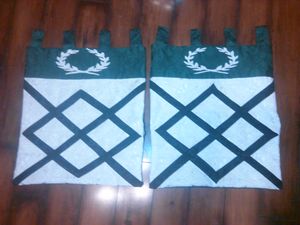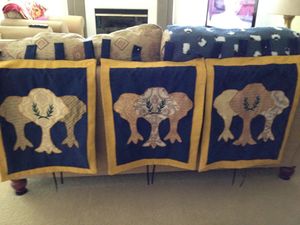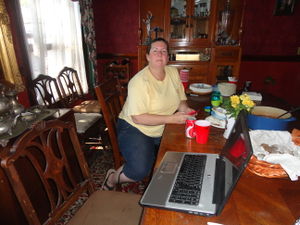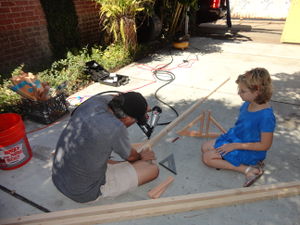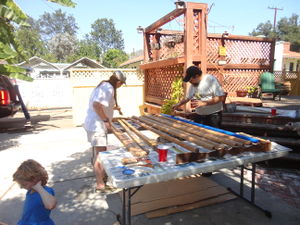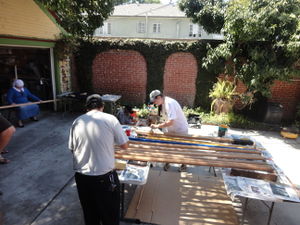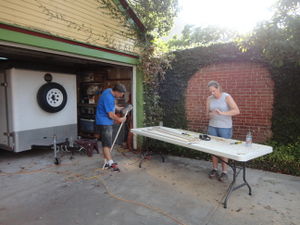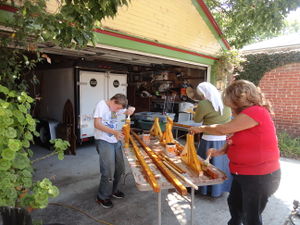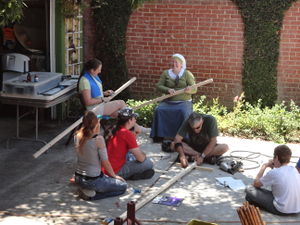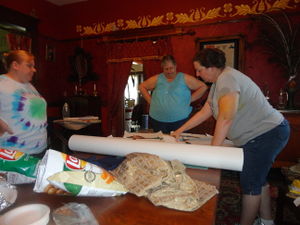Gonfalon Project: Difference between revisions
BaronGiles (talk | contribs) |
(Fixed broken links) |
||
| Line 1: | Line 1: | ||
{{Gonfalon|photo=[[Image:GonfalonDePiensa.jpg|300px]]|photocaption=A gonfalon bearing the arms of the commune of Piensa, Tuscany, Italy.|status=Active|artist= | {{Gonfalon|photo=[[Image:GonfalonDePiensa.jpg|300px]]|photocaption=A gonfalon bearing the arms of the commune of Piensa, Tuscany, Italy.|status=Active|artist=Unknown}} | ||
Inspired by a desire to simultaneously beautify Caid and answer the eternal question "What are we going to present at PhelanLeBlanc Anniversary next week?" | Inspired by a desire to simultaneously beautify Caid and answer the eternal question "What are we going to present at PhelanLeBlanc Anniversary next week?," the Barons of Gyldenholt ([[Giuseppe Francesco da Borgia]] and [[Giles Hill]]) created the Gyldenholt Gonfalon Project, with the ambitious goal of presenting every Barony with two gonfalons bearing that Barony's arms. | ||
Gonfalons (from the early Italian word <i>confalone</i>) are --quoting Wikipedia|https://en.wikipedia.org/wiki/Gonfalon -- a type of heraldic flag or banner, often pointed, swallow-tailed, or with several streamers, and suspended from a crossbar in an identical manner to the ancient Roman vexillum. They were first adopted by Italian medieval communes, and later by local Guilds, Corporations and Districts. The difference between a gonfalon with long tails and a standard is that the gonfalon displays the device on the non-tailed area, while the standard displays badges down the whole length of the flag. | |||
==Specifications for Gonfalons== | ==Specifications for Gonfalons== | ||
Finished dimensions are 20" by 23" (not including the loops at the top of the banner). | Finished dimensions are 20" by 23" (not including the loops at the top of the banner). Lord [[Dafydd_ap_Tomas|Dafydd ap Tomas]] designed the pole and base, and created a downloadable [[Media:GonfalonPolePlan.pdf|gonfalon banner plan]] for their construction. | ||
| Line 12: | Line 14: | ||
Image:GonfalonsAltavia.jpg|Altavia: Argent, a fret sable and on a chief vert a laurel wreath argent. (April 1982). <br>Makers: [[Dyrfinna_Drengsdottir|Dyrfinna Drengsdottir]] and [[Brynjólfr_Brandsson|Brynjólfr Brandsson]]. | Image:GonfalonsAltavia.jpg|Altavia: Argent, a fret sable and on a chief vert a laurel wreath argent. (April 1982). <br>Makers: [[Dyrfinna_Drengsdottir|Dyrfinna Drengsdottir]] and [[Brynjólfr_Brandsson|Brynjólfr Brandsson]]. | ||
Image:ImageName.JPG| | Image:ImageName.JPG|<i>needs caption</i> <br><i>Blazon and registration date</i> <br>Maker: | ||
Image:ImageName.JPG| | Image:ImageName.JPG|<i>needs caption</i> <br><i>Blazon and registration date</i> <br>Maker: | ||
Revision as of 08:50, 30 October 2015
Inspired by a desire to simultaneously beautify Caid and answer the eternal question "What are we going to present at PhelanLeBlanc Anniversary next week?," the Barons of Gyldenholt (Giuseppe Francesco da Borgia and Giles Hill) created the Gyldenholt Gonfalon Project, with the ambitious goal of presenting every Barony with two gonfalons bearing that Barony's arms.
Gonfalons (from the early Italian word confalone) are --quoting Wikipedia|https://en.wikipedia.org/wiki/Gonfalon -- a type of heraldic flag or banner, often pointed, swallow-tailed, or with several streamers, and suspended from a crossbar in an identical manner to the ancient Roman vexillum. They were first adopted by Italian medieval communes, and later by local Guilds, Corporations and Districts. The difference between a gonfalon with long tails and a standard is that the gonfalon displays the device on the non-tailed area, while the standard displays badges down the whole length of the flag.
Specifications for Gonfalons
Finished dimensions are 20" by 23" (not including the loops at the top of the banner). Lord Dafydd ap Tomas designed the pole and base, and created a downloadable gonfalon banner plan for their construction.
Baronial Arms on the Gonfalons
Altavia: Argent, a fret sable and on a chief vert a laurel wreath argent. (April 1982).
Makers: Dyrfinna Drengsdottir and Brynjólfr Brandsson.- ImageName.JPG
needs caption
Blazon and registration date
Maker: - ImageName.JPG
needs caption
Blazon and registration date
Maker:
Gonfalon Gallery
Three Gyldenholt gonfalons: "Azure, a hurst within a bordure Or".
Makers: Staeina Halfdanardottir, Ceara ingen Chonaill.Celebrate! Lady Staeina finishes the first gonfalon.
Mistress Ceara taking a moment's break.
Lord Tomas and Astrid work on a base assembly.
LadyJulianna and Lord Sigbiorn Sigmundarsson staining poles.
Please report any errors or omissions to Giles.
